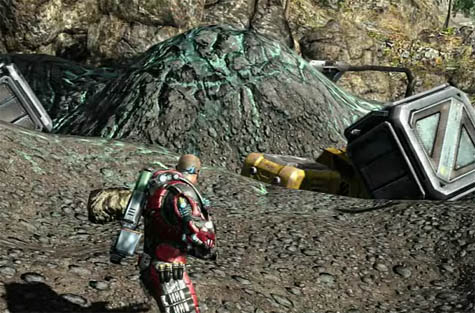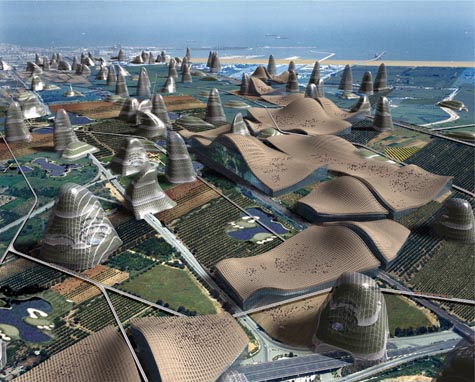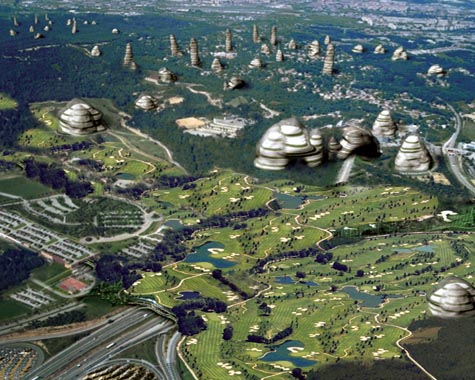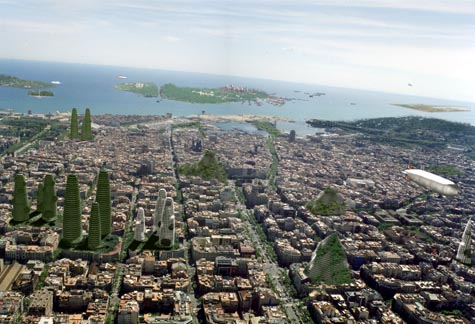Tactical Landscaping and Terrain Deformation
 [Image: A screenshot from Fracture by LucasArts. Via Wired].
[Image: A screenshot from Fracture by LucasArts. Via Wired]. Over on Wired this weekend I read about a game called Fracture, by LucasArts, which features "terrain deformation" as a central factor in gameplay.
Fracture is "a game centered on the wanton reformation of land masses," Wired reports; the author then goes on to introduce us to the game's "terrain deformation mechanics."
"Every player is equipped with a tool called an Entrencher," we read. The Entrencher "gives them the ability to raise or lower most surfaces at will," including the surface of the earth itself:
- Gone are the days of studying a level, and simply memorizing sniper positions and the fastest routes. Resourceful players will be digging trenches, raising their own cover and manipulating level elements to fortify their positions... fundamentally altering the way levels are played.
- Can't find a way across that slime pit? Raise the ground underneath it. You can also terrain-jump by leaping as you raise the ground beneath your feet, launching yourself into the air.
Using weapons like the Tectonic Grenade, you can reshape the planet. Quoting from the official Fracture website:
- The ER23-N Tectonic Grenade sets off localized shockwaves when detonated, causing small, concentrated earthquakes that raise the immediate terrain around the point of impact. The weapon is extremely useful for shaping the terrain and providing cover.
 [Image: A screenshot from Fracture, by LucasArts, showing a pyroclastic elevator at work].
[Image: A screenshot from Fracture, by LucasArts, showing a pyroclastic elevator at work].There are even Subterranean Torpedoes that burrow into the planet and create landforms on the surface far away.
 [Image: A screenshot from Fracture by LucasArts].
[Image: A screenshot from Fracture by LucasArts].Of course, the idea that an instantaneous and semi-magmatic reshaping of the earth's surface might have military implications is an interesting one – and probably not far from technological realization. I've written about the weaponization of the earth's surface before, but Fracture seems to illustrate the concept in a refreshingly accessible way.
However, there are many historical precedents for the idea of politicized terrain creation, and these deserve at least a passing mention here.
I'm thinking, in particular, of David Blackbourn's recent book The Conquest of Nature: Water, Landscape, and the Making of Modern Germany. The "making" in Blackbourn's subtitle is meant literally, as the book looks at coastal reshaping, bog- and marsh-draining, and other projects of imperial hydrology; these were the activities through which the territory of Germany itself was physically shaped.
It was terrain deformation: a militarized reshaping of the earth's surface under orders from Frederick the Great. Frederick sought to transform the lands of northern Germany – then called Prussia – in order to create more space to rule.
In his book, Blackbourn describes what these imperial "hydro-technicians" actually did:
- The task of filling in the squares on Frederick's grids remained. That meant ditching and diking the future fields, constructing sluices, uprooting the old vegetation and planting willows by the new drainage canals, preparing the still heavy, intractable soil, building paths and bridges, houses, farms, and schools, all the while maintaining the new defenses against the water.
These were lands created through military intervention in order to host a particular form of political governance.
In this context, then, Fracture would seem to be simply an accelerated - or what Sanford Kwinter might call an "adrenalated" – version of this tactical landscaping.
 [Image: Celestial Impact].
[Image: Celestial Impact].Meanwhile, a commenter over on Wired points out that there are conceptual similarities between Fracture and another game called Celestial Impact.
In Celestial Impact, "the landscape is fully deformable in all directions."
"Build and dig your way around the landscape in various strategic ways," we read, ways that are "not limited to destruction":
- [T]he players also have the ability to add terrain to the landscape in the middle of combat using a special tool called Dirtgun. With the Dirtgun, players can add or remove terrain during combat as they see fit, simply by aiming and firing the dirtgun. Depending on the chosen action, this will either add or remove a chunk of dirt from the landscape. So as the teams are battling, the landscape receives vast changes opening up for various tactical approaches each team can use.
In many ways, this sounds like a weaponized version of Behrokh Khoshnevis's building-printer – subject of one of the earliest posts on BLDGBLOG – here remade as a kind of propulsive instant-concrete mixer retrofit for imperial military campaigns.
As Discover described Khoshnevis's machine back in 2005, "a robotically controlled nozzle squeezes a ribbon of concrete onto a wooden plank. Every two minutes and 14 seconds, the nozzle completes a circuit, topping the previous ribbon with a fresh one. Thus a five-foot-long wall rises – a wall built without human intervention."
Now make an accelerated, portable, and fully weaponized version of this thing, put it in a videogame, and you've got something a bit like Celestial Impact.
Here are some screenshots.
 [Image: From The re-naturalization of territory by Vicente Guallart].
[Image: From The re-naturalization of territory by Vicente Guallart].Finally, I couldn't help but think here of architect Vicente Guallart. Guallart's work consistently seeks to introduce new geological forms into the built infrastructure of the city – artificial mountains, for instance, and "new topographies" through which a city might expand.
 [Image: From The re-naturalization of territory by Vicente Guallart].
[Image: From The re-naturalization of territory by Vicente Guallart].I suppose one question here might be: what would a videogame look like as designed by Vicente Guallart? Would it look like Fracture? If Vicente Guallart and Behrokh Khoshnevis teamed up, would they have created Celestial Impact?
But a more interesting, and wide-ranging, question is whether designing videogame environments is not something of a missed opportunity for today's architecture studios.
After all, how might architects relay complex ideas about space, landscape, and the design of new terrains if they were to stop using academic essays and even project renderings and turn instead to videogames?
It seems like you can take your ideas about terrain deformation and instant landscapes and nomadic geology and you can license it to LucasArts, knowing that tens of thousands of people will soon be interacting with your ideas all over the world; or you can just pin some images up on the wall of an architecture class, make no money at all, and be forced to get a job rendering buildings for Frank Gehry.
So would more people understand Rem Koolhaas's thoughts on cities if he stopped writing 1000-page books and started designing videogames – games set in some strange quasi-Asiatic desert world of Koolhaasian urbanism?
Or do all of these questions simply mistake popularity for engaged comprehension?
The larger issue, though, is whether or not architecture, increasingly popular as a kind of Dubai-inspired freakshow (rotating skyscrapers! solar-powered floating hotels!), is nonetheless not reaching the audience it needs.
 [Image: From The re-naturalization of territory by Vicente Guallart].
[Image: From The re-naturalization of territory by Vicente Guallart].If architects and architecture writers continue to use outmoded – I might even say totally irrelevant – forms of publication, such as $20/copy university-sponsored magazines and huge books purchased by no one but college librarians, then surely they can expect only people currently enrolled in academic programs even to be aware of what they're talking about, let alone to be enthusiastic about it or appreciative of the implications.
$100 hardcover books do absolutely nothing to increase architecture's audience.
So what would happen if architects tried videogames?
 [Image: The constructed geologies of Vicente Guallart, from How To Make a Mountain].
[Image: The constructed geologies of Vicente Guallart, from How To Make a Mountain].In any case, terrain deformation, dirtguns set on build-mode, and other forms of militarized landscape creation – these seem like good enough reasons to me to add gaming consoles to a design syllabus near you.





Comments are moderated.
If it's not spam, it will appear here shortly!
well, maybe "Koolhaasian urbanism" in the real material world could happen sooner than we think...
the wall street journal has a great article on "designer cities: the development of the superstar urban plan." one of the master plans profiled, zaha hadid's kartal, shares some similarities with the lucas arts game as well as vicente guallart's work...
http://online.wsj.com/article/SB121693005482282163.html?mod=googlenews_wsj
http://www.skyscrapercity.com/showthread.php?t=569079
http://www.arcspace.com/architects/hadid/kartal_pendik/kp.html
I agree with the premise, but I want to take it another step- augment architecture curricula with games, thereby making the subject more accessible to everyone...and then augment all other currecula the same way! First-person area studies! MMORPG sociology! Turn-based hexgrid MBA programs!
But if you really look at it, VGs are ALREADY all about architecture, as you've pointed out before. All spaces in videogames are consciously designed, often with a far more clear and direct purpose than the structures we inhabit every day.
doubters: google "half life citadel" if you are unconvinced
Geoff,
For what it is worth, at UNSW in Sydney, the first year architecture studio is centred around using the Unreal Engine as a design and documentation tool. Tutorials are spent running around the students constructions wielding all the sorts of oversized sci-fi weaponry that characterises the FPS world.
In the context of teaching in first year, it is fairly successful method of breaking assumptions of what an architecture education is in the mind of the student should be all about.
I would like to see how a grad course/masters would deal with the game engines as a legitimate platform however, and as yet have not heard of any. Has anyone else heard of such a course?
As a recent graduate of one of these academic worlds i can attest that your comment that the old means of theoretical conversation need to be greatly altered. with advances in tech we are able to fully realize and convey ideas that before would only be sketched in so many views on paper. Sketch books have a place but not much can beat handing someone a pair of 3d glasses and having them look at a model on your screen that they can nearly occupy. (this can EASILY be done TODAY with rhino, and i am sure many other programs)As i watch movies like Wall-E or experience some of these new amazing video games i see the possibilities of allowing the average person to assess, access, and experience theoretical design. No longer will there have to be a divide between the designer and those they are designing for. (this thought scares the old school)
Well, there is a lot I could say here, being a Dutch game designer :)
1. Did the Prussians do anything involving the creation of land the Dutch didn't do before them, starting in the 17th century and continuing today? ( http://en.wikipedia.org/wiki/Zuiderzee_Works )
Enough nationalist pride.
2. Fracture is not the first game to use landscape modification (and I doubt LucasArts claims this to be the case). As far as I know, the first game to include raising and lowering the landscape was Populous ( http://en.wikipedia.org/wiki/Populous ) from 1989. It is not even the first 3D action game to use landscape modification: that was Red Faction ( http://en.wikipedia.org/wiki/Red_Faction ), which allowed the player to modify the level's geometry.
This doesn't mean Fracture is bad or unoriginal, of course. It sounds like LucasArts did a fair job of building a polished game around an interesting mechanism. The challenge is how to combine a classical, well-understood level design approach with the (in theory) dramatically increased player freedom that landscape modification offers.
3. I suspect a videogame designed by Vicente Guallart, or at least involving what I know of his theories, which is very little, would probably look like Sim City, only with vastly more powerful landscape modification tools. The challenge of such a game would be providing the player with tools that allow her to really use the landscape while making it hard to screw up. So it would probably need to encode the knowledge that allows Guallart to do what he does (or proposes one could do).
4. Architecture is slooooowly being adopted in videogame development. Very slowly. Videogame design requires one to be a dilettante in 10,000 disciplines. Designing the geometry of levels so that it corresponds to the game's fiction, evokes the right emotions, enables the right kind of gameplay, and fits the technical limitations is a big job. Architecture students and architecture books have been spotted in level design departments.
5. Could a videogame be used to showcase architecture? Sure... to some degree. If you could use a movie to showcase architecture, you could use a videogame, or at least the technology. It is much harder, I think, to combine the core idea of a particular work of architecture with a particular videogame. The ranges of emotions that are typically evoked do not overlap much.
A separate problem is that the audiences don't overlap much either. $100 hardcover books do absolutely nothing to increase architecture's audience, but they do have an audience - an audience that, if they play videogames at all, probably doesn't play them for the same reasons they read those books. I think this might indeed be mistaking popularity for engaged comprehension. Still, it is fun to think about it.
And that's why I read this blog. Please continue!
- Jurie
one more note. If anyone is interested, the Danish Firm BIG has a building that has been transformed into a Counterstrike level. on their web site there are links to download and screen shots. I can't figure out how to link right to that page but if you go looking for it, it is the Odensa Aqua Center. www.big.dk
I'm with Jurie. I like your blog. I like the BIG pictures, the short entries and the fawning comments, which you can't find in those 20 dollar journals. Plus, the people in those can't publish themselves like you can, so other people have to review it to see if it's original or a contribution to architectural thought. I could go on, but I have to go to the library to read something in Grey Room and then maybe a big book (without pictures). And while I read these things, and learn something new, I'll take comfort knowing that you pity me.
By the way, this computer that I am reading your journalism on, cost a lot more than $20 bucks!.
Thanks for your thoughts, anonymous; I'm glad your reading comprehension skills are as high as you obviously think they are.
@marcus
"I would like to see how a grad course/masters would deal with the game engines as a legitimate platform however, and as yet have not heard of any. Has anyone else heard of such a course?"
No! I think it is important to stress that "architects making games" is much more interesting than "architects modeling projects via game engines". There is quite a lot of overlap between architectural means of production and gaming, I think the real paradigm shift is mapping the imagination associated with architectural representation into game-space.
I do have about .04 to add re: journals and such, but that will have to wait.. Great post and subsequent discussion!
SCORCHED EARTH is a 1991 turn-based artillery game that features landscape modification. Granted it is 2-D, but remakes like Scorched 3D (2001) remedy that.
it's a bit of an old link, but...
http://news.bbc.co.uk/1/hi/education/982346.stm
fabulous post!
Game idea: balloon like terrain; with tumbling mountains and messy water table. Flexible enough to bend but not break. Not for the stomach feeble!
Populus was a great game, one which I played mostly to rain pestilence and thrown an ocassional volcano to my enemies.
Speaking of architects prototyping and promoting their work and thought in different medias, Elena Manferdini prototypes her architectural ideas in fashion, i.e.clothes.
For the current architectural star system, the better venue might be movies, television, stage, and other presentations that are more spectacle-oriented and less participatory. After all, a common space where anyone can build? You'd have to be running something like Urban Versioning System in your legal codes. (http://www.lulu.com/content/2734646)
I can see somebody like UNStudio having their media being software for cell phones and GPS units, mostly gently guiding up until some parametric threshold is triggered. "Traffic clearly shows it's time to build a wall right here!"
Geoff, you might find this thoughtful discussion of Blackbourn's book at CTlab interesting.
Mike
This is a great article, it comments on a subject
I myself feel will be of prime importance in the near future. I am currently about to graduate with an Associates in
Drafting for both Architecture and Engineering,and i started taking such classes on computers.
Currently drafting classes are abandoning the table and switching to CAD programs. Which are quickly adapting to the various file formats used in computer games. I feel the field will soon reflect itself using the gaming world as a great asset.
@ Marcus
I work for a company called Simmersion who use game technology for architectural visualisation and urban planning. Our core software is called Simurban and it is basically a 3D video game engine designed to take in real world data such as digital elevation models, aerial photography and photogrammetric data for buildings to simulate the real world in a real-time 3D environment.
I have also taught a 3D visualisation class at the Canberra Institute of Technology for a spatial sciences course using our Simurban software.
We have a large number of Sydney councils as our clients and in some cases it is a requirement to submit a development proposal in our format for approval.
Our software allows it's users to do accurate sun shadow and line of sight analysis on the fly in real-time.
Check it out here!
www.simurban.com
I just want to throw out there that I am more than a little disappointed that I have not once seen the Profession of Landscape Architecture mentioned in this article or any of the comments, as we are the ones trained in not designing structures, but any space outside structures, and most games take place mostly outside.
That being said, while any "traditional" designer would, in my mind, make a video game a much more realistic place, with a more lived in feeling, if those designers did not also have a good mind for games, it would be a lost cause. If a designer was able to create levels for a game that was both fun to play, and innovative architecturally, I think it would without a doubt raise awareness.
The thing to remember is, this is already possible. If you go purchase a game like halflife, or halflife 2, or even the upcoming Little Big Planet, you have the ability to design your own levels.
I have a feeling if a designer was able to work within one of these realms, they would certainly have the power to create levels as good or better than the levels that come from the development studio.
@ Frank
Video game Level Designers take a lot more than just the landscape into account when designing levels. The placement of items, AI characters, puzzles, traps etc all play a larger role in game design than the landscaping. It is about making the player enjoy where they are, or even be scared of where they are, whatever emotion the game designers are trying to get across.
Far Cry 2 looks like it will have some of the best game level creation tools available:
Far Cry 2 Map Editor Video
If you don't know anything about game design, you won't be a good level designer.
Also keep an eye on Mycosm
A virtual worlds creations tool my company is working on.
Videogames are already very much about architecture. I know they've been mentioned before, but the Half Life series are an absolutely amazing example of this.
These are games that are essentially on a rail. The only way to go is forward, perpetually, except that "forward" often means "through that interesting looking pile of rubble" rather than "through the large locked garage door in front of me". The architectural beauty of Half Life (especially in Half Life 2) is that the levels are so expertly designed that you think you are checking out an interesting looking cubby that might contain a health pack or scrap of ammo, but it's actually the way forward. It's especially enlightening to play through the later iterations (Half Life 2 Episodes 1 and 2, Portal) with the developer commentary, where they expound on some of the tricks used to guide your eyes to the correct area of the environment.
I probably wouldn't even be here if I hadn't at some point realized the videogame-architecture connection, actually.
The FPS videogame approach to architecture has one big advantage, the viewpoint is at eye level. The 1960s and 1970s were full of architectural monstrosities built with all thought towards their appearance as architectural drawings, artists' renderings and gloriously detailed models. These buildings were often unapproachable, unusuable and unpleasant to anyone approaching them by land.
Creating FP eye level renderings required a lot of work. Sure, every project had a few of them, but given a choice of portraying the long slog across the barren piazza or the brief but pleasant moment of passage beneath the gateway, guess which rendering was actually produced for the presentation?
Now any reasonably talented architect can create a 3D model of a proposed project and then walk around it, and let other people walk around it, inside and out. This makes it much easier to recognize flaws in the design from the user's viewpoint. In fact, it might be interesting to experience some familiar landmarks from the FP view. What does the Taj Mahal really look like, if you start your tour at the front door? How about the Chrysler Building? The Pantheon?
Having traversed all too many sterile plazas and endured too many unworkable buildings, I think videogame technology will lead to much better and more usable architecture.
Now, I wanna see Fracture VS. Portal. Throw Chell in there as your enemy. :) (I know, different engine.)
Post a Comment